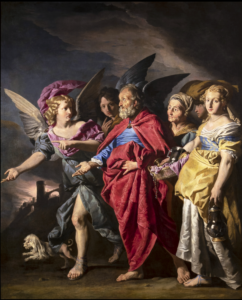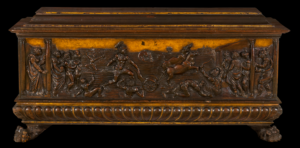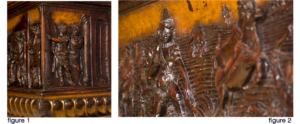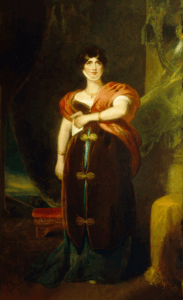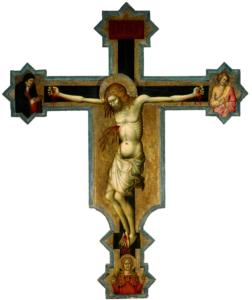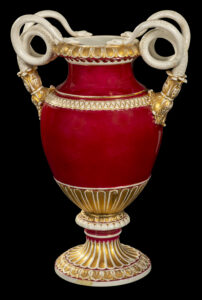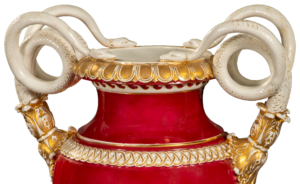Although little is known about the Italian artist Pietro Martire Neri, this portrait illustrates his stunning mastery of beautiful coloration and intricate stylistic detail.
Category Archives: M&G Collection Online
Cassone
Walnut with parcel gilt
Tuscan, 16th century
While the Museum & Gallery is most widely known for its collection of religious Old Master paintings, the founder of the museum also developed “supplemental collections of period furniture, icons, decorative arts, textiles, and objects of art” (Drama & Beauty: Great European Paintings from the Bob Jones Collection). The original intent of these sub-collections was to provide a setting for the artwork that would allow modern viewers to understand and appreciate the religious and domestic contexts in which the paintings might first have been displayed.
By the 1970s notable authorities of furniture considered these once-ancillary collections to rival some of the world’s best. Joseph Aronson, who wrote a number of authoritative histories of furniture, “considered the Renaissance furniture collection the finest in America” and lent his expertise to write a catalog containing Furniture in the Bob Jones University Collection, which was published in connection with M&G’s 25th anniversary celebration in 1976.
Specifically, this Italian Renaissance walnut and parcel-gilt Cassone epitomizes the history, breadth, and educational value of M&G’s period furniture collection. Purchased for the collection in 1966, the Cassone came from French & Company, in New York City. Founded in 1907, French & Company was once considered one of the world’s largest dealers and had provided art, furnishings, and even interior design to some of the best-known families of America’s Gilded Age, including the Vanderbilts, Astors, Gettys, Rockefellers, Mellons, and duPonts (and subsequently in the collections of the major museums endowed by those families). The company thrived under its first two generations of leadership and was noted for its library of documentation, which provided purchasers with exhaustive histories (or provenance) of the items acquired. The company was then sold several times, and much of its remaining stock was auctioned in 1968. M&G is pleased to provide a home for a number of French & Company pieces.
The history of cassoni dates back to the fourteenth century. Originally functioning as wedding chests for new couples—and paraded through the streets in wedding procession—cassoni often contained the bride’s dowry and became cherished treasures in newly established homes. The decoration of cassoni grew in sophistication over the years and entire workshops were devoted to the artform. Frequently portraying Biblical, classical, or mythological subject matter, the front panels of these chests displayed any number of craftsmanship, from carving and gilding to built-up gesso decoration and painting. Even notable artists such as Sandro Botticelli, Paolo Uccello, and Donatello applied their skills to decorate cassoni for the wealthiest clientele.
M&G’s Cassone likely dates from 16th-century Tuscany and is constructed of carved walnut. Standing on diagonally-set lion paws, the chest’s special features include gilded gadrooning, the detailed and deeply-set carving on the front and side panels, as well as the ogee dome molding. The unique top paired with the end panels shifts the most intricately carved subject matter to the front of the chest and only the front two-thirds of each side (figure 1). This technique differs from the usual appearance of cassone, which are most often depicted at the foot of a couple’s bed in Renaissance art. It’s likely that this particular cassone was commissioned to solve a specific architectural challenge in its new home—possibly resting in the shallow recess of a wall or passageway. As such, it is not typical of the traditional traveling chest, but represents “a step in the evolution of the credenza form” (Aronson).
Also of interest, the remarkably dimensional, carved frieze (figure 2) has been variously explained as a battle scene or a depiction of Death riding an ox-drawn chariot through a sacrificial scene. The key clues in the frieze include bystanders observing the action from the safety of colonnades on the left and right. Most prominently on the front left is a woman holding a round vessel and a man who appears to be strangling a sheep held aloft in front of him. The front right draws the viewer’s focus to a king, surrounded by an entourage. The central figure in the scene is indeed a man on an ox-drawn chariot, riding through a plain, which is covered by furrows and ridges. Near him are 5 warriors with weapons drawn. More difficult to see in the distance above him on the plain (moving from left to right) are a ridged-back dragon, a tree, and a walled city on a hill.
Since cassoni often depict a felicitous message for newlyweds, using classical, biblical, or mythological imagery, deciphering the elements is a fascinating undertaking. In the case of this M&G cassone, newlyweds are reminded of the exploits and love contained in the story of Jason and Medea. While there are many Greek and Roman variations of the story, the key elements remain.
Jason’s father was the rightful king of Iolcus, but was overthrown by his half-brother, Pelias. Jason’s life was saved by his mother, who sent him away to be protected and educated by the centaur Chiron. When Jason returned and wished to re-take the throne, Pelias required that he undertake a quest to find and return the Golden Fleece from where it lay in Colchis. After a series of adventures Jason and the crew of his ship Argo (hence the collective name Argonauts) arrived in Colchis, where Jason requested the fleece from King Aietes. Aietes agreed to give Jason the Golden Fleece if he accomplished three feats of bravery intended to be deadly to Jason. Unknown to the king, his daughter, Medea, was charmed to fall in love with Jason and help him survive and succeed.
First, Aietes required that Jason plow a field with fire-breathing oxen, but Medea gave him an ointment to protect him from the flames. Jason next had to sow the field with dragon’s teeth. When he did so, the teeth turned into full-grown warriors (spartoi). They would have killed Jason, had he not been told how to defeat them. He threw a stone into their midst and the confused warriors, not knowing who had thrown the stone, attacked each other.
Finally, Jason had to retrieve the Golden Fleece from where it hung on an oak in the sacred grove of Ares. The grove was protected by an undying, unsleeping dragon. Here again Medea protected Jason by administering an herbal potion that made the dragon sleep. Finally, the hero and his love Medea flee from her father and return to take the Iolcus throne from Jason’s uncle. Unfortunately, their happiness was short-lived; but that part of the couple’s story is—understandably—not portrayed by the artisan of this very special Cassone.
Dr. Stephen B. Jones, M&G volunteer
Sources
Aronson, Joseph. Furniture in the Bob Jones University Collection. 1976.
Drama & Beauty: Great European Paintings from the Bob Jones Collection. Museum & Gallery, Inc. in association with D. Giles Limited, 2022.
Published 2024
Crucifix
Tempera and gold on panel, c. 1380
Francesco di Vannuccio
Sienese, active c. 1356-1389
Among the many treasures in M&G’s collection hangs a unique and exemplary example of late fourteenth-century Italian art. In 1374, the Black Death struck the city of Siena and its surrounding countryside for the third time in twenty-six years. The return of the plague devastated the city, which was already struggling from political and economic instability. Tragically, most of the victims of this wave of the Black Death were children. In the wake of this period of grief, an unknown patron commissioned Sienese artist Francesco di Vannuccio to paint a crucifix or croce dipinta (painted cross) for his or her church. During the fourteenth century, large painted crucifixes were a fixture in Italian churches. They depicted Christ dead on the cross flanked by Mary and John the Evangelist and were often highly decorated in gold. Positioned above the altar, these crucifixes provided a focal point for worshippers.
Francesco’s patron included an unusual request: the image of Mary Magdalene facing out toward the worshipper with her hands raised in the ancient orans pose of prayer. Of the 214 surviving Italian fourteenth-century crucifixes, only fourteen have Mary Magdalene present. Of those, only one intact crucifix, M&G’s, features this extremely rare imagery of Mary Magdalene. With its unique depiction of a ministering female saint, Francesco’s crucifix was born out of the need for spiritual solace in the aftermath of the Black Death.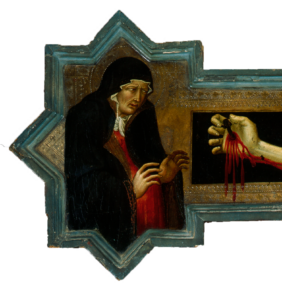
Little is known about Francesco di Vannuccio. Few of his paintings survive. He signed only one work, a double-sided panel now housed in Berlin’s Gemäldegalerie. Despite this small surviving body of work, all of Francesco’s paintings demonstrate that he possessed a keen eye for intricate decoration. He was also closely attuned to the religious concerns of his day. Francesco’s depictions of physical and emotional suffering made him stand out among his fellow artists. In his crucifix, Christ’s arms are pulled taut by the weight of His body. His fingers curl and His feet twist around the piercing nails. Blood spurts in a wide arc from the wound in His chest and drips from His head, hands, and feet. While other crucifixes show the mother of Christ serenely grieving, Francesco painted her face deeply lined in anguish. Poignantly, she reaches for her Son, something not seen in any other fourteenth-century crucifixes. Francesco’s Mary is a mother mourning the loss of her Child, a sight many worshippers would have personally related to following the third outbreak of the Black Death.
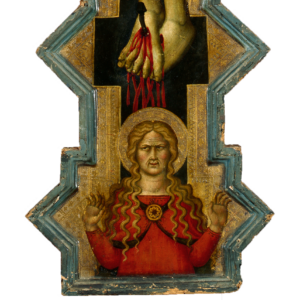 Beneath Christ’s feet, Mary Magdalene prays. Despite being one of the most popular female saints during the fourteenth century, Mary Magdalene’s presence in crucifixes is rare. Most depict her small in scale contemplating the cross. She does not directly engage with the worshipper as Francesco’s does. During the fourteenth century, Mary Magdalene was revered both as the “blessed sinner” (tradition combined her with the repentant sinful woman in Luke 7) and as the “apostle to the apostles” because of her encounter with the resurrected Christ and her role of spreading the news to His other followers. Painting the blood flowing down to her head and her bright red robes, Francesco depicted Mary Magdalene as being baptized in Christ’s blood. With her hands raised in the orans position and facing the worshipper, Francesco also depicted her as the “apostle to the apostles.” The ancient orans pose represented the worshipper’s openness to God’s grace and was a gestural expression of faith in Christ’s death and resurrection. By the fourteenth century, this prayer position was reserved solely for the clergy. Thus, Francesco’s Mary Magdalene is an apostle actively ministering to the worshippers.
Beneath Christ’s feet, Mary Magdalene prays. Despite being one of the most popular female saints during the fourteenth century, Mary Magdalene’s presence in crucifixes is rare. Most depict her small in scale contemplating the cross. She does not directly engage with the worshipper as Francesco’s does. During the fourteenth century, Mary Magdalene was revered both as the “blessed sinner” (tradition combined her with the repentant sinful woman in Luke 7) and as the “apostle to the apostles” because of her encounter with the resurrected Christ and her role of spreading the news to His other followers. Painting the blood flowing down to her head and her bright red robes, Francesco depicted Mary Magdalene as being baptized in Christ’s blood. With her hands raised in the orans position and facing the worshipper, Francesco also depicted her as the “apostle to the apostles.” The ancient orans pose represented the worshipper’s openness to God’s grace and was a gestural expression of faith in Christ’s death and resurrection. By the fourteenth century, this prayer position was reserved solely for the clergy. Thus, Francesco’s Mary Magdalene is an apostle actively ministering to the worshippers.
Painting Mary Magdalene in this active role, Francesco and his patron were likely inspired by Catherine of Siena (1347-1380). Catherine was a writer and preacher who advocated spiritual reform. She was beloved for her piety and her healing the sick during the third wave of the Black Death. In her ministry, Catherine looked to Mary Magdalene as an example of religious devotion and service. Writing to her female followers, she urged them to “follow the Magdalen, that lovely woman in love, who never let go of the tree of the most holy cross. No, with perseverance she was bathed in the blood of God’s Son…she so filled her memory and heart and understanding with it that she became incapable of loving anything but Christ Jesus.” Mary Magdalene’s love for Christ drove her to brave the Roman soldiers guarding the tomb and proclaim the news of the Resurrection to anyone who would listen.
For worshippers living in the grief-filled years of the late fourteenth century, the sight of Mary Magdalene offered comfort both in the cleansing power of Christ’s sacrifice and His Resurrection. Almost six and a half centuries later, the message of Francesco di Vannuccio’s gleaming cross continues to resonate today.
Dr. Allison Wynne Raper, Adjunct Instructor at York Technical College
For further reading:
Ole J. Benedictow. The Complete History of the Black Death. Woodbridge, Suffolk: The Boydell Press, 2021.
Catherine of Siena. The Letters of Catherine of Siena. Translated by Suzanne Noffke, O.P. 4 Volumes. Tempe, AZ: Arizona Center for Medieval and Renaissance Studies, 2000-2008.
Katherine Ludwig Janson. The Making of the Magdalene: Preaching and Popular Devotion in Late Medieval Italy. Princeton: Princeton University Press, 2000.
Published 2024
Meissen Vase
Porcelain, Mid-19th century
Ernst August Leuteritz
German, 1818 – 1893
Augustus II was elector of Saxony, King of Poland, and Grand Duke of Lithuania. In the early 1700s he established Saxony as one of the most economically advanced areas of Europe and built himself a magnificent residence in Dresden where he maintained a lavish court. He was obsessed with the highly fashionable porcelain pieces imported from China and had a large collection of “white gold” (an appropriate name, for some of the more desirable pieces of Chinese porcelain were virtually worth their weight in gold). His collection not only impressed guests, it depleted his treasury. He was in constant need of the metallic variety of gold.
About 1700 in Prussia, a bright young apothecary’s apprentice, Johann Böttger, was bragging that he had found the goldmachertinktur (translation: gold maker tincture), a concoction that could convert base metals into gold. In an attempt to put the lad in his place, the apothecary asked Böttger to demonstrate the transmutation. The procedure was done under close supervision, and it worked! It produced several ounces of highly refined gold. (Böttger never revealed how he performed the trick, nor was it ever repeated.) The Prussian king learned of the success at making gold and seeing a way to fill his treasury, had Böttger put in “protective custody.” Knowing what happened to alchemists who failed to produce gold for their royal masters, Böttger panicked, escaped, and fled.
Böttger made it to Saxony. There his Prussian pursuers would not have authority to apprehend him. However, Augustus II learned of Böttger’s transmutation and had him captured and placed in a dungeon-like, medieval fortress. He could purchase his freedom with gold. Eventually the quantity demanded would not only fill the treasury, but also add some significant white gold pieces to Augustus’ collection. At one point Augustus even alerted the mint to be ready to strike coins with the gold that would soon be arriving. It never came.
Ehrenfried von Tschirnhaus, an educated German mathematician and scientist, was trying to make porcelain by heating various white materials to high temperatures. His experiments either failed or made a type of glass. Since Böttger did not seem to be progressing in producing a goldmachertinktur, Augustus hired Tschirnhaus to supervise Böttger’s work. Originally Böttger looked down on Tschirnhaus’ experiments but realizing that perhaps white gold might spare his life, Böttger took interest in Tschirnhaus’ work.
A white clay mined near Meissen, a small town 16 miles from Dresden, contained kaolin and when mixed with various other materials, produced porcelain. Experimentation refined the recipe and eventually a porcelain equal to that imported from China, was made.
Augusts named Tschirnhaus director of the porcelain factory he planned to establish in Meissen. The white clay mines were nearby, and Meissen was on a major river so the wood needed for the kilns could be easily delivered. In 1708, before the factory could be built, Tschimhaus died suddenly. A few months later Böttger was named head of the Saxon Royal Porcelain Manufactory, the first factory to produce hard-paste porcelain in Europe.
Sculptors were hired to mimic the shapes of oriental pieces, and chemists were brought in to develop colored and clear glazes. The Meissen manufactory, as it came to be known, became highly profitable. Böttger’s living conditions greatly improved, but he did not completely regain his freedom. He remained director of Augustus’ manufactory until his death in 1719.
In the following 300 years, the Meissen manufactory constantly produced porcelain pieces. Sometimes the company was well managed and produced high quality, fashionable, and much sought after works. At other times, Meissen struggled under a variety of challenges including contaminants in the clay, export tariffs, limited production, outdated designs, and political turmoil (such as Napoleon and, later Hitler). Once Sèvres in France and both Minton and Wedgewood in England perfected porcelain production, Meissen’s bottom line suffered.
As mass manufacturing methods of porcelain and decoration became perfected, Meissen faced a decision: use modern methods to produce quantities of inexpensive pieces or continue with handcrafted and hand painted pieces. The company decided to produce only high quality, handmade and hand-decorated pieces. Present day Meissen pieces can be as valuable as the very old ones.
Ernst August Leuteritz and M&G’s Schlangenhenkelvase
Ernst August Leuteritz was born in Fischergasse (city near Meissen) in 1818 and became an apprentice in the Meissen manufactory at 18 years of age. He immediately demonstrated exceptional abilities in modeling and embossing. The next year he was given a stipend for a year’s leave of absence to study under Rietschels at the Art Academy in Dresden. Being very timid, he found the experience extremely difficult and returned to Meissen after a short stay; however, he was convinced to complete his training. His artistic growth and refinement of skills led Meissen to extend his leave for further studies. After several years he returned to the manufactory and was promoted to the position of “Modeler.” In 1849 he became Meissen’s “Head of Design,” a position he held until his retirement in 1886. He died in 1893.
During his tenure with Meissen, Leuteritz designed hundreds of ornate figurines, centerpieces, candlesticks, serving dishes, vases and virtually every other type of porcelain piece imaginable. Today his works are found in many museums and personal collections and fetch high prices at auctions.
Leuteritz designed several vases adorned with serpents. In 1853 he designed the schlangenhenkelvase (translation: snake-handled vase) in M&G’s collection. It is an amphora shaped vase on an ornately-sculpted, round pedestal. On each side a pair of snakes emerge from acanthus leaves, forming a loop and resting their heads on the rim. The schlangenhenkelvase in M&G’s collection was very popular in the second half of the 19th century and came in different sizes. M&G’s vase is 19 inches high and 13 inches wide.
The body of M&G’s vase is a deep garnet with accents of gold and white. The gold on the leaves and snakes appears worn in areas. The vase, however, still maintains its original gold application.
The Meissen Hallmark
The secret formula for making porcelain was protected by Meissen, until it was leaked to Austria through corporate espionage. By 1717, a factory in Vienna began producing porcelain; and by 1760, there were thirty European porcelain manufactories. In order to identify Meissen pieces, blue underglaze markings were added.
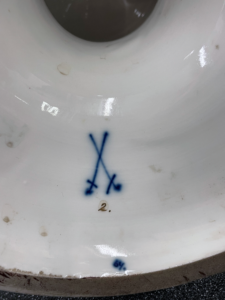 By 1720, the crossed swords from the Elector of Saxony’s coat of arms were introduced and by official decree in 1731, was required to appear on all Meissen porcelain. Meissen’s crossed-swords logo is among the oldest and longest used trademarks, as well as being among the most often forged. Variations of the sword’s curvature, hilt placement as well as other embellishments help to date the pieces. Since the hallmark was hand painted, there is considerable variety even among authentic logos.
By 1720, the crossed swords from the Elector of Saxony’s coat of arms were introduced and by official decree in 1731, was required to appear on all Meissen porcelain. Meissen’s crossed-swords logo is among the oldest and longest used trademarks, as well as being among the most often forged. Variations of the sword’s curvature, hilt placement as well as other embellishments help to date the pieces. Since the hallmark was hand painted, there is considerable variety even among authentic logos.
Under the base of M&G’s schlangenhenkelvase is the blue underglaze Meissen crossed-sword logo. Experts recognize it as genuine. The mark indicates that this vase was possibly made in the late 19th or first quarter of the 20th century. The underglaze “67” identifies the garnet painter, and the gold “2” indicates either the painter of the gold or that M&G’s vase may be one of a set.
Now the good news: you can have your own authentic schlangenhenkelvase without having to search the internet or attend an art auction where fake vases have been known to exist. Meissen still manufactures schlangenhenkelvase as part of their Masterworks Collection. They are not stock items; each one is produced to order and includes hand painted floral bouquets on the amphora. View the strikingly beautiful vase you could own by clicking on the Purchase a Vase link below. However, be prepared for a bit of a shock.
William Pinkston, Retired Educator and M&G volunteer
References
Video of the discovery of how to manufacture porcelain
Video of Meissen manufacture of porcelain, including a schlangenhenkelvase being painted
The Book of Meissen (Schiffer Book for Collectors) by Robert D. Rontgen
Meissen Porcelain Identification and Value Guide by Jim and Susan Harran
Published 2024

